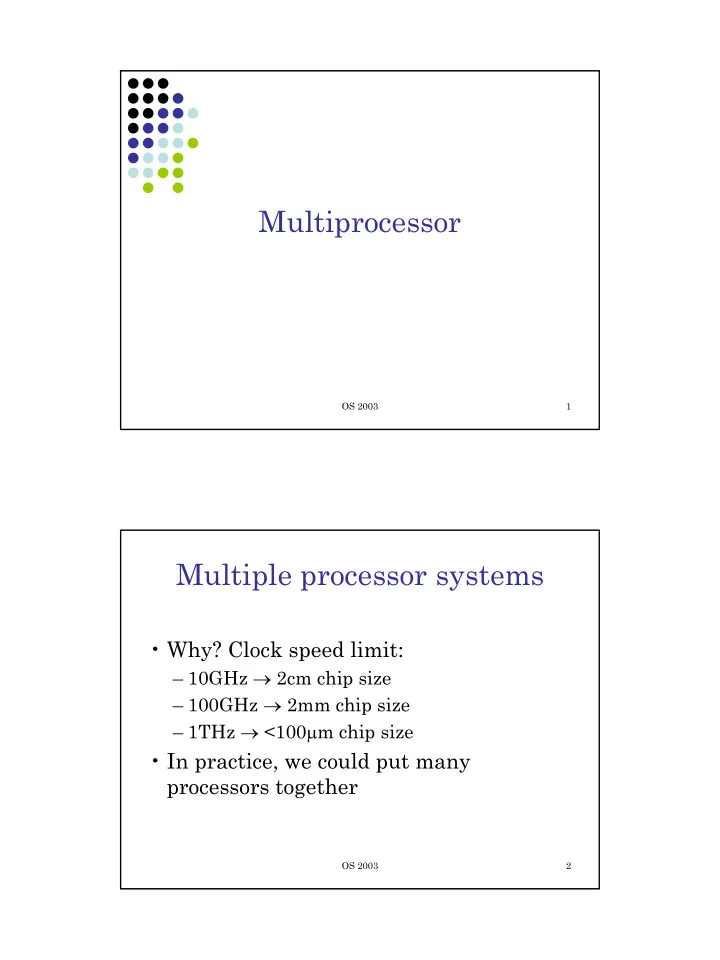

Multiprocessor OS 2003 1 Multiple processor systems • Why? Clock speed limit: – 10GHz → 2cm chip size – 100GHz → 2mm chip size – 1THz → <100 µ m chip size • In practice, we could put many processors together OS 2003 2
Architectures M M M M c c c c c c M M c c M c c M c c Shared Interconnect Internet memory c c M c c M c c M M c c c c c c M M M M Shared memory Loosely coupled Tightly coupled OS 2003 3 What does each process sees • A process running on a CPU sees: – Usual virtual memory (paged) – Can write in memory and read back a different value (another process changed it) •IPC – Organize shared memory (OS) OS 2003 4
BUS based MP architecture CPU CPU Mem CPU CPU Mem Bus Bus 2 CPUs is fine, 64 is not cache bus contention CPU CPU Mem Bus cache private memory OS 2003 5 Cache • Try to keep most used pages (lines usually) in cache • When memory in changed (written), other caches need to be notified of the change • There are specific cache transfer protocols • If local memory is present the compiler should do a good job at separating what goes in main memory versus what stays in local memory OS 2003 6
Crossbar switches 1 Q M M M M M M N P P P No conflicts (if memory is available) P P P 1 Processor n connects to memory q OS 2003 7 UMA, NUMA classes • UMA (uniform memory access): – Uniform access, read/write – Memory accesses have all the same characteristics • NUMA (non-uniform): – Single address space visible to all CPUs – Access to remote memory is slower than local – E.g. 100 processors, difficult, then something has to give, in practice the uniform access time is the tradeoff OS 2003 8
How it works • The memory is split between nodes • Clearly the access to a remote node’s local memory is slower • A request from one of the nodes has to either go to the bus, possibly cached, or to the local memory • Caches need to be up-to-date all the time OS 2003 9 OS types • One OS in each CPU, N CPUs operate as N independent computes – What happens in loosely coupled MP systems – No much sharing of memory, CPU cycles, etc. between processes (e.g. a CPU loaded while others idle) • Master-slave – Single OS, allocating CPUs and memory – Single data structures (memory page tables, process tables, etc.) – Only the master runs the OS • Symmetric multiprocessing (e.g. Windows, Linux) – SMP, each CPU can run the OS – Make sure updates of e.g. page tables are done consistently (mutexes, different parts and different critical regions within the OS) OS 2003 10
MP synchronization • Appropriate synchronization procedure are needed – Disabling interrupt doesn’t work • TSL instruction, locking also the BUS while reading/writing atomically – Lock_bus – Read, Write – Unlock_bus • Otherwise, if the bus doesn’t support TSL, there’s always Peterson’s solution OS 2003 11 MP scheduling • 2-D problem – Multiplexing in time (time sharing) – Multiplexing in space (space sharing) • Multiple threads in parallel on different CPUs • Take decisions also on how much processes and groups are related – Different users might start different processes – Same user starting a group of processes • The scheduler should avoid blocking CPUs simply because a process is holding a lock • Also, it might make sense to keep the same process recurrently running on the same processor OS 2003 12
Scheduling (for time-sharing) • Give additional quanta to processes holding (global) locks to avoid blocking other CPUs – Smart scheduling • CPU affinity – Keep the same process on the same CPU to exploit cache at best OS 2003 13 Scheduling (for space sharing) • Schedule multiple threads (of a single process) in parallel to many CPUs at once • In pure space-sharing there’s no multiprogramming on the CPUs – E.g. if we have 64K processors there’s no much need of multiprogramming • Mix of space and time sharing OS 2003 14
Hyper-threading • PIV processors • Execute 2 threads at once • Since many instructions do different things they also use different subset of the CPU • Idea! Why not keep most of the CPU always busy by allowing the execution of another thread • This is clearly all done in hardware OS 2003 15 Software • Send/receive model – Two blocking calls – send/receive messages • Asynchronous – The send returns immediately – The message buffer of course cannot be modified until the message is actually sent – Buffering issues (double, triple buffering) •Copy on write: only copy the buffer if the code tries to write on it OS 2003 16
RPC • Remote procedure call client stub server stub OS OS network OS 2003 17 Complications • Based on RPC – DCOM (Microsoft) – Corba (Open standard) • Same as RPC but object oriented • Language to describe parameters, functions and objects • The marshaling of parameters is simpler – Parameters need to be packed in a uniform format to be shipped across network and possibly different architectures OS 2003 18
Recommend
More recommend